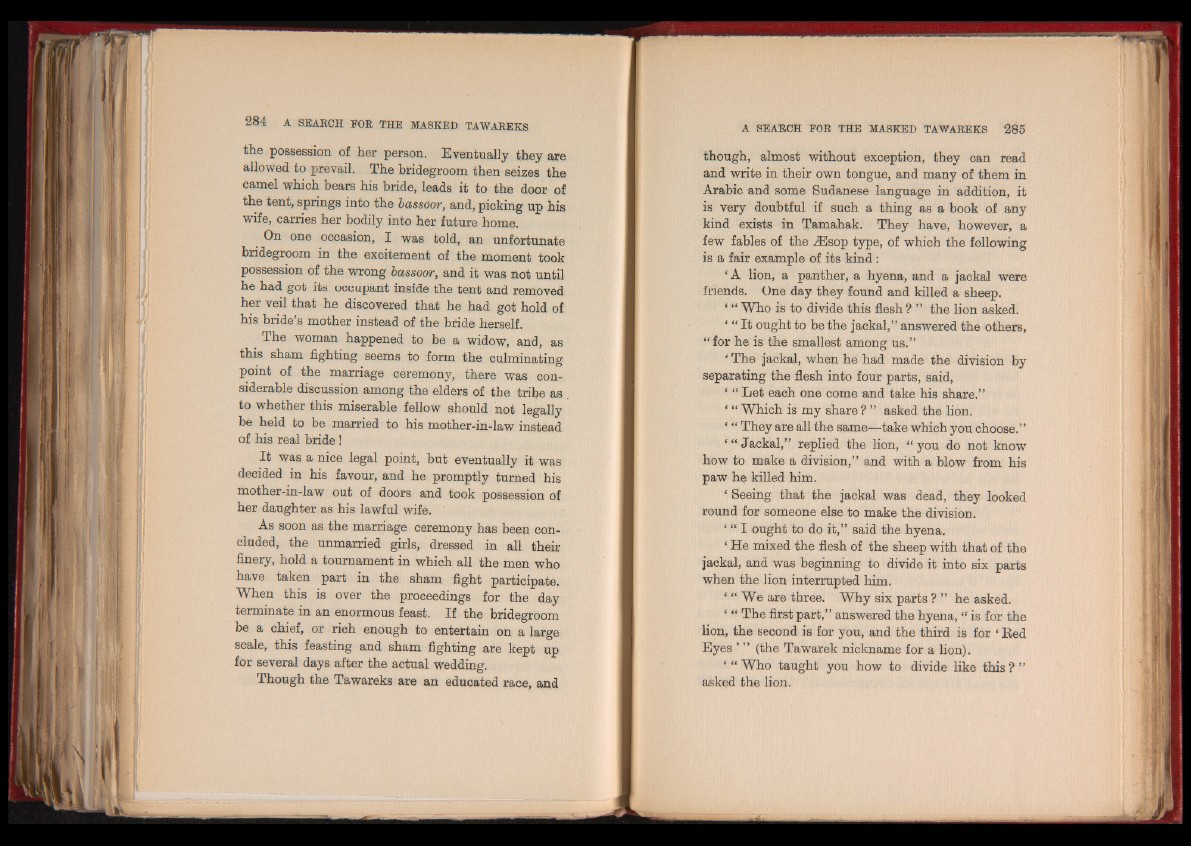
the possession of her person. Eventually they are
allowed to prevail. The bridegroom then seizes the
camel which bears his bride, leads it to the door of
the tent, springs into the bassoor, and, picking up his
wife, carries her bodily into her future home.
On one occasion, I was told, an unfortunate
bridegroom in the excitement of the moment took
possession of the wrong bassoor, and it was not until
he had got its occupant inside the tent and removed
her veil that he discovered that he had got hold of
his bride s mother instead of the bride herself.
The woman happened to be a widow, and, as
this sham fighting seems to form the culminating
point of the marriage ceremony, there was considerable
discussion among the elders of the tribe as
to whether this miserable fellow should not legally
be held to be married to his mother-in-law instead
of his real bride!
It was a nice legal point, but eventually it was
decided in his favour, and he promptly turned his
mother-in-law out of doors and took possession of
her daughter as his lawful wife.
As soon as the marriage ceremony has been concluded,
the unmarried girls, dressed in all their
finery, hold a tournament in which all the men who
have taken part in the sham fight participate.
When this is over the proceedings for the day
terminate in an enormous feast. If the bridegroom
be a chief, or rich enough to entertain on a large
scale, this feasting and sham fighting are kept up
for several days after the actual wedding.
Though the Tawareks are an educated race, and
though, almost without exception, they can read
and write in their own tongue, and many of them in
Arabic and some Sudanese language in addition, it
is very doubtful if such a thing as a book of any
kind exists in Tamahak. They have, however, a
few fables of the ¿Esop type, of which the following
is a fair example of its kind:
‘A lion, a panther, a hyena, and a jackal were
friends. One day they found and killed a sheep.
‘ “ Who is to divide this flesh ? ” the lion asked.
‘ “ It ought to be the jackal,” answered the others,
“ for he is the smallest among us.”
‘ The jackal, when he had made the division by
separating the flesh into four parts, said,
‘ “ Let each one come and take his share.”
‘ “ Which is my share ? ” asked the lion.
‘ “ They are all the same—take which you choose.”
‘ “ Jackal,” replied the lion, “ you do not know
how to make a division,” and with a blow from his
paw he killed him.
‘ Seeing that the jackal was dead, they looked
round for someone else to make the division.
‘ “ I ought to do it,” said the hyena.
‘ He mixed the flesh of the sheep with that of the
jackal, and was beginning to divide it into six parts
when the lion interrupted him.
‘ “ We are three. Why six parts ? ” he asked.
‘ “ The first part,” answered the hyena, “ is for the
lion, the second is for you, and the third is for ‘ Red
Eyes ’ ” (the Tawarek nickname for a lion).
‘ “ Who taught you how to divide like this ? ”
asked the lion.